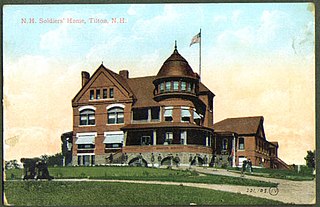
An old soldiers' home is a military veterans' retirement home, nursing home, or hospital, or sometimes an institution for the care of the widows and orphans of a nation's soldiers, sailors, and marines, etc.

Cave Hill Cemetery is a 296-acre (1.20 km2) Victorian era National Cemetery and arboretum located at Louisville, Kentucky. Its main entrance is on Baxter Avenue and there is a secondary one on Grinstead Drive. It is the largest cemetery by area and number of burials in Louisville.
Stones River National Battlefield, a 570-acre (2.3 km2) park along the Stones River in Rutherford County, Tennessee, three miles (5 km) northwest of Murfreesboro and twenty-eight miles southeast of Nashville, memorializes the Battle of Stones River. This key battle of the American Civil War occurred on December 31, 1862 and January 2, 1863, and resulted in a strategic Union victory.

Camp Chase was a military staging and training camp established in Columbus, Ohio in May 1861 after the start of the American Civil War. It also included a large Union-operated prison camp for Confederate prisoners during the American Civil War.
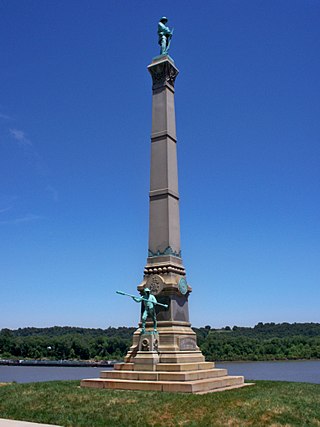
The Confederate Monument in Louisville is a 70-foot-tall monument formerly adjacent to and surrounded by the University of Louisville Belknap Campus in Louisville, Kentucky, United States. Relocation of the monument to Brandenburg, Kentucky, along the town's riverfront began November 2016, and was completed in mid-December. The granite and bronze structure was erected in 1895 by the Muldoon Monument Company with funds raised by the Kentucky Woman's Confederate Monument Association. The monument commemorates the sacrifice of Confederate veterans who died in the American Civil War.

Louisville in the American Civil War was a major stronghold of Union forces, which kept Kentucky firmly in the Union. It was the center of planning, supplies, recruiting and transportation for numerous campaigns, especially in the Western Theater. By the end of the war, Louisville had not been attacked once, although skirmishes and battles, including the battles of Perryville and Corydon, took place nearby.
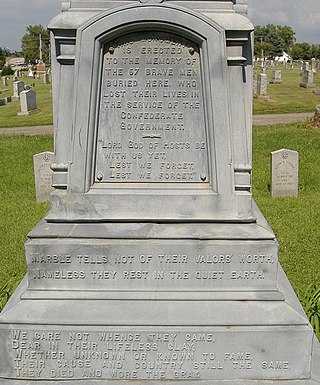
The Confederate Monument of Bardstown, in Bardstown, Kentucky was erected in 1903 in the Bardstown St. Joseph's Cemetery to honor the sacrifice of 67 Confederate States Army soldiers, who died during the American Civil War. Some 17 of the soldiers are still unknown.
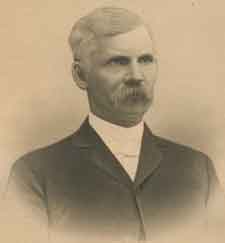
Bennett Henderson Young was a Confederate officer who led forces in the St Albans raid, a military action during the American Civil War. As a lieutenant of the Confederate States Army, he entered Vermont from Canada and occupied the town of St. Albans.
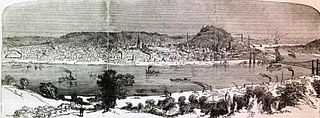
During the American Civil War, the Ohio River port city of Cincinnati, Ohio, played a key role as a major source of supplies and troops for the Union Army. It also served as the headquarters for much of the war for the Department of the Ohio, which was charged with the defense of the region, as well as directing the army's offensives into Kentucky and Tennessee.
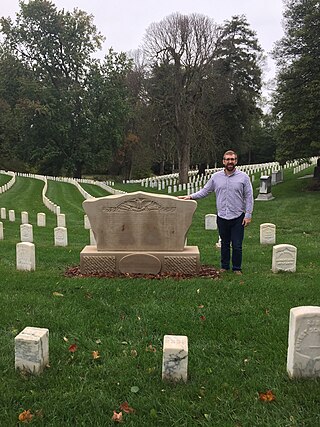
The 32nd Indiana Monument, also known as the August Bloedner Monument, honors the Union soldiers of the 32nd Indiana Volunteer Infantry Regiment, also known as Indiana's "1st German" regiment, who died in the Battle of Rowlett's Station on December 17, 1861, near Munfordville, Kentucky. Originally placed at Fort Willich, near Munfordville, in January 1862, the monument was moved to Cave Hill National Cemetery at Louisville, Kentucky, in June 1867. Due to its fragile condition, the monument was removed from the national cemetery in 2008. After undergoing conservation treatment at the University of Louisville, it was placed on display at the Frazier History Museum lobby in August 2010. Although it is no longer in its original location, the 32nd Indiana Monument is generally considered to be the oldest surviving memorial to the American Civil War. A replacement monument at Cave Hill National Cemetery was dedicated in December 2011.

The Union Monument in Louisville is located in Cave Hill Cemetery in Louisville, Kentucky. It was built in 1914 from granite, honoring unknown soldiers who fought in the Union during the American Civil War. It is in front of the large number of Union soldiers buried at Cave Hill.

The Confederate Monument in Cynthiana is located on the outer edge of Cynthiana, Kentucky in Battle Grove Cemetery. It was the first monument to the Confederate States of America dedicated in the State of Kentucky, and long believed to be the first Confederate memorial anywhere. Due to the 32nd Indiana Monument having been moved from its original location, the Cynthiana monument is the oldest Civil War monument still standing at its original location, where the second Battle of Cynthiana started, in the then-new town cemetery.

The Colored Soldiers Monument in Frankfort, Kentucky's Green Hill Cemetery, at the junction of US 60 and US 421, is the only Kentucky monument honoring black soldiers that participated in the American Civil War, and one of only four in the entire United States. Erected by the Woman's Relief Corps No. 8, an auxiliary of the Grand Army of the Republic, it was unveiled on July 4, 1924. The only other monument built by GAR in Kentucky is the GAR Monument in Covington.

The Confederate Monument in Danville, originally located between Centre College and the First Presbyterian Church at the corner of Main and College Streets in Danville, Kentucky, was a monument dedicated to the Confederate States of America that is on the National Register of Historic Places. The monument was dedicated in 1910 by the surviving veterans of the Confederacy of Boyle County, Kentucky and the Kate Morrison Breckinridge Chapter of the United Daughters of the Confederacy (UDC). In 2021, it was relocated to a museum in Meade County, Kentucky.

Confederate Memorial Park is an Alabama State Park located in Mountain Creek, in rural Chilton County, Alabama, United States. Its address is 437 County Road 63, Marbury, Alabama 36051. It is sometimes found with the same address in Verbena, Alabama 36091.

Lexington, Kentucky was a city of importance during the American Civil War, with notable residents participating on both sides of the conflict. These included John C. Breckinridge, Confederate generals John Hunt Morgan and Basil W. Duke, and the Todd family, who mostly served the Confederacy although one, Mary Todd Lincoln, was the first lady of the United States, wife of President Abraham Lincoln.

The Confederate Monument in Owensboro, Ky., was a 16-foot-tall, two-part object — a 7-foot-tall bronze sculpture atop a 9-foot-tall granite pedestal — located at the southwest corner of the Daviess County Courthouse lawn, at the intersection of Third and Frederica Streets, in Owensboro, Kentucky. Nearly 122 years after the monument was dedicated in September 1900, the monument was dismantled in 2022, beginning with the removal of the sculpture in May 2022; the sculpture was placed in storage, pending a decision on what to do with it.

The Confederate Memorial in Nicholasville is a historic statue created in the Jim Crow era and located on the Jessamine County courthouse lawn in Nicholasville, Kentucky, ten miles south of Lexington, Kentucky.
The Civil War Trust's Civil War Discovery Trail is a heritage tourism program that links more than 600 U.S. Civil War sites in more than 30 states. The program is one of the White House Millennium Council's sixteen flagship National Millennium Trails. Sites on the trail include battlefields, museums, historic sites, forts and cemeteries.
























